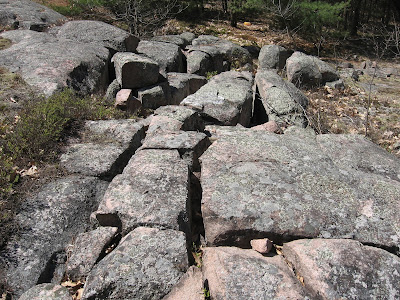These are images that I never dreamed I would capture, for two reasons. One is that the Common Five-lined Skink is wary and moves like greased lightning. Sneaking up close to this small lizard with a Canon PowerShot A530 is virtually impossible, imagine trying to approach within one foot of a bird! The few photos below are the result of over twenty hours of patiently waiting in the hot sun, hoping the skink would become accustomed to my prescence and come out to bask.
The other reason I never thought I would acquire photographs of the Common Five-lined Skink (Plestiodon fasciatus) is that I had no idea they were living within walking distance of home. I have seen them on the rocks along the Skootamatta River shoreline near Storring's Bridge, and they are reputed to inhabit the Sheffield Conservation Area ... where I have hiked for hours and seen not a one. This lizard's abode borders the trans-Canada Trail about one kilometer east of town; here's the view from the trail, looking to the south.
One of the rock outcroppings where the skinks were observed; I believe there are at least three distinct lizards in the area. This is prime Common Five-lined Skink real estate, plenty of fissures, crevices and overhangs creating perfect places for basking, nesting, hibernating and hiding from predators. It's also a great place for a careless person to fall or break a leg.
The bluish tail indicates that this individual is a juvenile. The first Common Five-lined Skink observed in this area (spotted by a friend, about thirty feet to the south of where the pictures were taken) was less boldly striped and its tail was more gray than blue; I think it was a mature female.
The little reptile – about 12 or 13 cm in length – seldom emerged fully into the sunlight, leaving at least his (or her?) tail in the shade. I don't know if this was for the purpose of maintaining an optimal body temperature, or because it felt more comfortable knowing it could make a hasty retreat if necessary.
When my friend sighted the first Common Five-lined Skink she saw only its head poking out from among dead leaves in a crevice and mistook it for a Garter Snake, so – a quick primer on the differences between snakes and lizards.
Legs can sometimes be a distinguishing characteristic, definitely in this case as the Common Five-lined Skink is our sole lizard species. But in general this isn't a reliable way to tell snakes and lizards apart since there are many species of legless lizards. Another difference is that lizards have external ear openings, whereas in snakes they are lacking. As a substitute for hearing snakes rely on sensing vibrations transmitted through the ground. And finally, lizards have moveable eyelids and snakes do not – while he was sunning himself this little guy would blink now and again.
The external ears and moveable eyelids weren't visible from a distance, making it easy to mistake the Common Five-lined Skink for a snake. However, the legs were quite obvious when it came out of hiding and trundled across the rock right in front of us. And my camera? It was sitting ten feet away – of course. All in all, though I didn't get a picture of the first encounter I'm happy that she espied the lizard and pointed it out to me, because I was looking the other way at that moment and would never have noticed it. And would still be unaware that Ontario's one and only lizard is hanging out practically in my back yard ...








